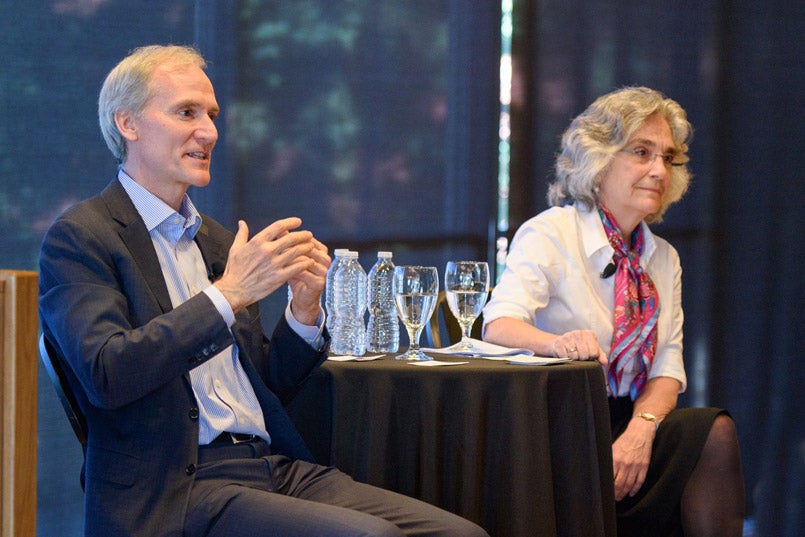November 16, 2017
An update on campus historical names
I’m writing to update the campus community on the Advisory Committee on the Use of Historical Names on Campus.
I met with the committee on Monday to get an update on its progress. Yesterday, a group of students concerned about the process voiced their views in a campus march, and I met with representatives of the group last evening. I respect their views, and I want to discuss here how we intend to move forward and bring the process to conclusion.
The advisory committee of faculty and students was established in 2016 by then-President John Hennessy and then-Provost John Etchemendy. The committee was formed in response to concerns expressed by students and others in our community about campus streets and buildings named for Junipero Serra, the 18th-century priest who established the California mission network.
The committee has given diligent and thoughtful attention to its work. The members met at least 16 times between the group’s inception and the end of the 2016-17 academic year, and they engaged in many additional discussions by email.
The issues are complex, and the going has not been easy.
From the outset, the committee was asked to do two things: first, recommend principles addressing the conditions under which Stanford should consider removing the name of a historical figure from a campus landmark; and second, recommend whether any names currently on campus landmarks should be replaced based on those principles.
I have not participated in the committee’s work and have reached no conclusions on the issues. I have, however, inquired periodically about the committee’s progress.
After receiving an update in March of this year on the group’s challenges in coming to agreement, I conveyed that, if it would help move the process along expeditiously, the group could focus on the principles first, as indicated in the original charge, and then apply them to the specific case of Junipero Serra.
It may seem desirable to resolve the Serra naming issue in isolation. It is an issue that has deep personal and historical resonance for many members of our community, who bring a range of heartfelt viewpoints to it.
At the same time, I have heard clearly from our community the desire for an articulation of the rationale behind decisions that are made at the university. On the naming issue, the development of principles to inform decision-making is critical if we are to give members of our community a clear understanding of the basis for decisions that are made. Principles are also critical if we are to ensure consistent analysis and treatment of different naming issues in the future.
Until recently, the hope was that the advisory committee could conclude its work by the end of this quarter. However, it has become apparent that this goal will not be met. The committee reported to me on Monday that it has been unable to reach agreement about the principles, despite committed efforts by the members and extensive further discussion.
I believe, and members of the committee agreed when we met, that moving forward requires making use of all of the committee’s extensive research and deliberations to date but also asking others, with the benefit of fresh eyes, to complete the process.
To that end, I intend to ask two new groups, which will again include faculty and students, to engage on this project and bring it to conclusion. A first group will articulate the principles, and a second group then will apply those principles to the specific case of Junipero Serra. Based on my discussions with the current committee members, I believe this approach will facilitate a more efficient conclusion to the process that provides clear recommendations and supporting rationales on the two questions at issue.
I expect to appoint these groups in December. I will work with the chairs, yet to be identified, to establish a timeline for the groups’ work, with the firm aim of completing it before the end of the academic year. There is urgency and we want to move quickly, but we must also allow sufficient time for community input and committee deliberation. Again, their work will not start from scratch, but will be informed by the great deal of work that has already been done by the existing committee. The membership and charge to the groups will be publicly available.
As we work to set up this final phase of the effort, I also want to give members of the university community a chance to convey their thoughts and concerns to me directly. I have already benefited from input from the current committee members and the students mentioned above, but I will be scheduling additional office hours in November and December for others who wish to meet with me.
I know that members of our community are anxious for outcomes from this process and have waited a long time already. I want to thank those who raised these issues originally, who have kept a focus on them, and who have contributed important perspectives for the university to consider.
I believe it is important for the issues to be addressed in the deliberative manner that comes with having different members of our community reflect and advise on them through the committee process. The work done now will have intergenerational impact and live long after our own time at Stanford. I greatly appreciate the work of the current committee members who have invested significant time and thoughtfulness in this process, and I look forward to working with our community to bring it to a rapid conclusion.
